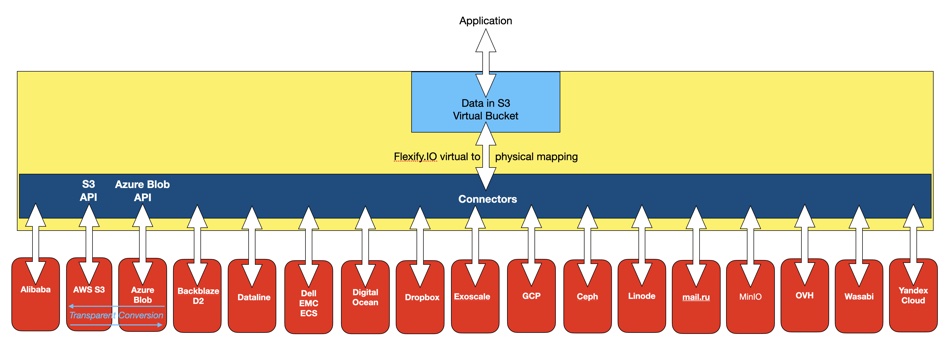Flexify.IO provides cloud storage virtualisation and migration software that offers customers cloud-agnostic object-based data storage. It enables and simplifies migration, and avoids dependency on a single cloud storage provider.
The concept is straightforward. An application reads and writes data from and to a virtual S3 bucket. The actual data is stored in a physical bucket in one of more than 20 storage locations, including Alibaba Cloud, Amazon Web Services (AWS) S3, Microsoft Azure Blob, Backblaze B2, Dataline, Dell EMC ECS, DigitalOcean, Dropbox, Exoscale, Google Cloud, Linode, Mail.ru Cloud, MinIO, OVH, Wasabi, and Yandex Cloud.

Flexify’s software tracks which physical storage location is used, and carries out API-based storage IO using connector modules to satisfy the read and write requests.
There is no support for file or block storage.
Migration matters
Data can be moved between these cloud service providers (CSPs) and on-premises storage locations, avoiding CSP lock-in. Specifically, Flexify transparently converts the S3 API to the Azure Blob API — so there is no need to convert S3-compatible applications to Azure Blob-compatible ones. It similarly translates between the S3-compatible API and Alibaba OSS APIs.
Data can be split across multiple locations and presented as being in a single (virtual) bucket. The data can also be migrated between these locations, with Flexify’s code taking care of errors and preventing downtime during a migration. Multiple Flexify instances (stateless engines) can be used in a migration process with a so-called slot-based distribution technique. This speeds the data transfer process.
No egress fees are payable when:
- Migrating from Azure or Google Cloud Platform to Amazon S3 region on the same continent;
- Migrating from Amazon Web Services or Google Cloud Platform to Azure region on the same continent;
- Migrating from Azure, Google Cloud Platform or Amazon Web Services North American regions to Backblaze B2 US or from European regions to Backblaze B2 EU;
- Migrating from Amazon Web Services S3 us- regions to Backblaze B2 US or from Amazon S3 eu- regions to Backblaze B2 EU;
- Migrating from Microsoft Azure or Amazon Web Services to Google Cloud Platform region on the same continent.
We’re told that a large gaming company recently worked with Flexify.IO to move more than 5PB of data from Amazon S3 to Google. The largest migration to date involved 1.5PB of data spread across two billion objects.
Management console
Flexify provides a management console that includes a migration wizard. Data access speed is improved by an asynchronous transfer design, in which object access commences before a whole object has been fetched by Flexify. The company claims that: “With proper regions configuration (so that you don’t send data across the Atlantic Ocean and back) you can expect delay of no more than a few milliseconds.”
This is a multi-user management console, supporting customers who want to manage multiple departments and users on Flexify.IO through a central administrator.
Flexify.IO is available as a cloud service, managed by Flexify, or it can be installed privately in a customer’s own cloud or on-premises. The Flexify (cloud-native) app is available in the Azure and Digital Ocean marketplaces, and a Community Edition can be downloaded from the Docker Hub.
The Community Edition is limited to a single machine and is not scalable. The main edition is horizontally scalable, with centralised management of geographically distributed engines.

Flexify founding and funding
Flexify.IO was started up in June 2015 by CTO Sergey Kandaurov and Corporate President & CEO Sergey Smirnov in Nizhniy Novgorod, Nizhegorod, Russian Federation. It raised an undisclosed amount of funding in May 2018, and has an office in St Petersburg, Florida. Its head of development, Alexander Bondin, is located in Novgorod, Russia, and Kandaurov is based in the Philippines.
Future development plans include adding support for smaller cloud providers, storing unstructured data in blockchain, and looking at near-real-time continuous synchronisation to keep two or more data stores in sync.
Check out a series of articles here to look further into Flexify.
Pricing









